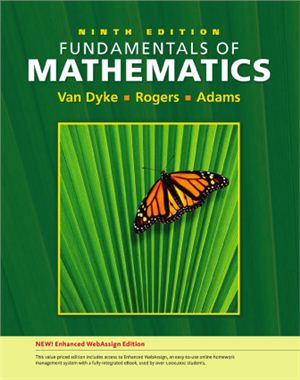Brooks Coole, 2009. - 864 pages.
clear exposition and the consistency of presentation make leaing arithmetic accessible for all. Key concepts are presented in section objectives and further defined within the context of How and Why; providing a strong foundation for leaing. The predominant emphasis of the book focuses on problem-solving, skills, concepts, and applications based on "real world" data, with some introductory algebra integrated throughout. The authors feel strongly about making the connection between mathematics and the mode, day-to-day activities of students. This textbook is suitable for individual study or for a variety of course formats: lab, self-paced, lecture, group or combined formats. Though the mathematical content of "Fundamentals of Mathematics" is elementary, students using this textbook are often mature adults, bringing with them adult attitudes and experiences and a broad range of abilities. Teaching elementary content to these students, therefore, is effective when it accounts for their distinct and diverse adult needs. Using Fundamentals of Math meets three needs of students which are: students must establish good study habits and overcome math anxiety; students must see connections between mathematics and the mode day-to-day world of adult activities; and students must be paced and challenged according to their individual level of understanding.
clear exposition and the consistency of presentation make leaing arithmetic accessible for all. Key concepts are presented in section objectives and further defined within the context of How and Why; providing a strong foundation for leaing. The predominant emphasis of the book focuses on problem-solving, skills, concepts, and applications based on "real world" data, with some introductory algebra integrated throughout. The authors feel strongly about making the connection between mathematics and the mode, day-to-day activities of students. This textbook is suitable for individual study or for a variety of course formats: lab, self-paced, lecture, group or combined formats. Though the mathematical content of "Fundamentals of Mathematics" is elementary, students using this textbook are often mature adults, bringing with them adult attitudes and experiences and a broad range of abilities. Teaching elementary content to these students, therefore, is effective when it accounts for their distinct and diverse adult needs. Using Fundamentals of Math meets three needs of students which are: students must establish good study habits and overcome math anxiety; students must see connections between mathematics and the mode day-to-day world of adult activities; and students must be paced and challenged according to their individual level of understanding.

